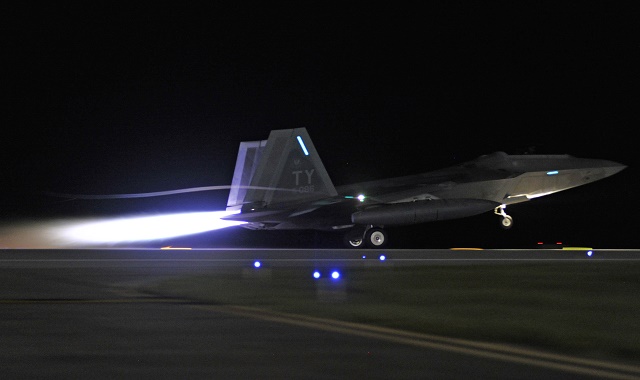Pratt & Whitney could soon be prying open boxes of Lockheed Martin F-22 Raptor engine manufacturing equipment and tooling to support an increase in depot overhauls of the thrust-vectoring, supercruise F119 turbofan engine due to increased operational use.
After the 187th production aircraft rolled off the Lockheed final assembly line in Marietta, Georgia, in 2011, the US Air Force placed the equipment and tooling in storage to support the aircraft and engine across the F-22’s planned 30-year life.
According to P&W, the aircraft’s recent entry into combat and an uptick in global deployments means a larger volume of F-22 engines will soon start arriving at the F119 heavy maintenance centre at Tinker AFB in Oklahoma for overhaul.
“They’re using the F-22 in a way where there’s more tactical air cycles. It’s being used in a harder manner than our specifications called for, so that may mean bringing in the engine sooner and more often,” P&W military engines president Bennett Croswell tells Flightglobal in an interview. “We’re working with the air force to make sure we have the capacity for that at Tinker AFB.”
Croswell says the F119 is exhibiting high reliability rates abroad, even in hot and dusty environments in the Middle East where the F-22 is currently escorting strike packages in and out of Syria and Iraq.

USAF F-22 Raptors recently deployed to Europe for the first time for joint training with allies and as a warning to Russia.
US Air Force
The engine’s hot section requires an overhaul at 2,000h and cold section cycles through Tinker AFB every 4,000h.
To ensure there are enough spare parts to support the increase in overhauls, Croswell says some of the manufacturing equipment that was mothballed will need to be pulled from storage to reproduce some out-of-production components.
Unlike the widely-support F100 powerplant for the Lockheed F-16 and Boeing F-15, which remain in production, the highly sophisticated F-22 was never approved for export, so only a limited number of F119s were produced before F-22 production was capped 563 aircraft short of the original requirement of 750. “Some of those spare parts could be a cold start. This going to be something a little new for us,” Croswell says.
Restarting Raptor and F119 production is the dream of many American air force generals – particularly Air Combat Command chief Gen Herbert “Hawk” Carlisle, who is concerned about the strain being placed on his ageing, shrinking and fatigued combat force.
Croswell says F119 production could be revived, however unlikely the scenario.
“I’m sure there would be some handful of parts where we’d have to go recreate the tooling, but we could do it if our customer decided they needed more engines,” he says. “But, I haven’t heard anything to suggest that’s going to happen."
In terms of F100 production, Croswell expects the assembly line in Connecticut to remain open at least until 2017 based on orders for Iraq’s F-16s and spare modules for other customers. However, there are some new sales opportunities on the horizon.
“We think there will be some other requirements from other countries that may buy additional aircraft,” he says. “I don’t know where the US government is on disclosing that.”
Source: FlightGlobal.com


























